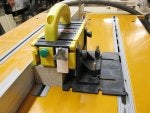For what it's worth:
-- First, I 'nevva' cut 45 degree miters on a router table. Believe that a well tuned table saw with the proper and sharp blade, miter gauge with stop to ensure repetitive lengths, or a sled for small pieces, is better.
-- Depending upon the stock species and thickness, the larger 3 HP routers probably will work better than smaller/light duty machines. Use only a 1/2" shank bit, not sure if there are 1/4" bits to cut 45 degree miters.
-- As others posted, when/if using a router table, utilize a backer on end grain to prevent blow out and a jig for repetitive cuts to the same lengths.
-- All the digital Little Black Boxes have a +/- tolerance built in, which could show up when closing the miters up.
-- Little Black Boxes need a battery which will need replacement. A replacement may not be on hand when needed, and/ or the replacement battery also is dead, or the replacement size may not be readily/commonly available when needed.
-- I cut my miters on the table saw. On my ol' Uni-saw, I set the 45 degree stop to about 48 degrees. Set it with my Starrett square or another known, accurate 45 degree gauge. I ran the blade to the stop, then backed it off until there was no light visible between the square/gauge and the blade. Did this because I once had a Little Black Box, which I tossed. I titled the blade until the readout said 45 degrees. Put my square to it, then my 45 degree gauge and saw light. Measured the angle with a protractor and sliding bevel and it 47 degrees.
-- Unless you drop or otherwise abuse an accurate square or other known gauge, they will remain true.


























